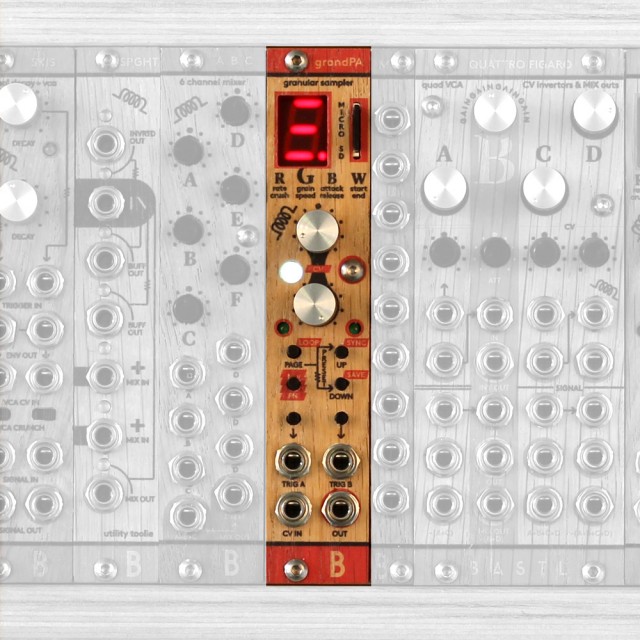
Here’s a video intro to the Bastl Instruments grandPa granular sample for Eurorack modular synthesizers:
The grandPa has 2 trigger inputs to trigger 2 different samples. CV input which is assignable to any sound parameter and signal OUTPUT. The CV input can be also used to trigger grain shift.
Grandpa reads microSD card accessible from the front panel and runs the same sound core as microGranny 2. For each sample, you can adjust: sample rate, crush, grain size, shift speed, attack, release (full release is hold), start and end position.
Features:
- granular sampler with microgranny 2.0 soundcore
- plays wav files from the microSD card, 22050 Hz, 16 bit, mono
- 12bit output
- adjustable sample rate (can go up to 44.1 kHz)
- trigger inputs for playing 2 different samples with different settings
- each trigger input has a button to do the trigger manually
- RGB led to indicate page (on each page the two knobs adjust different parameters)
- crush distortion
- adjustable grain size and grain shift (positive or negative)
- digital attack decay envelope
- start and end point
- no interpolation between grain jumps
- each sample has adjustable destination of CV input – it can go to any of the parameters
- grain sync – CV input can act as trigger input for triggering the grain shift
- can recognize 35 different samples on the microSD card (they need to be specific name)
- 35 presets (all settings of the 2 samples is one preset)
- CV input reacts in 0-10V range
- handmade in Brno, Czech republic
- front panel from oak wood, handmade custom knobs
- breakout for FTDi USB adaptor for hacking, opensource firmware (see github)
The Bastl Instruments grandPA is available for €173.00.

I have a 5U (MU) format modular (Mos-Lab system 1P) and I am always jealous of the vast amount of Eurorack modules available. I made my choice though and do not regret it! I love the larger format just for the fact that I love the larger physical interaction. The Mos-Lab sounds amazing as well.
very useful comment.
Wheres the fun putting sounds on a SD Card? How do you get a workflow in your modular with this?
It allows you to produce sounds that no other modular source ever could. It allows samplers to be integrated into modular gear. So the fun is in being able to modulate and mess with samples more easily in your modular workflow. An SD card is just a simple, cheap, and removable EPROM sub in these sorts of things.
The advantage of this is that it is controllable and modulate-able by all the variety that a modular offers.
Another SD card module, The Radio Music, http://www.thonk.co.uk/shop/radio-music-full-diy-kit/ lets you simulate tuning through the station on an old radio, with the cool difference that you select what is actually played on each station.
It is pretty damn cool and very different.
Nearly all granular modules in Eurorack format use sample playback from storage devices like USB or microSD. This can be good for certain uses, but can be extremely limiting from the modular point of view. There are a few modules like the Grain Shift or the Mutable Instruments Clouds that take live input (from other modules or external) and they are much more flexible concerning integration with the rest of the system you own. There isn’t anything this grandPA can do a Octratrack can’t do to samples.
Personally I find the Clouds much more integrated with my whole modular system, and I’m looking forward to trying it together with a Ginko Synthese Samplicer which also takes live input!
This isn’t trying to be those modules. A live input is mostly just a loop feature and does not live up to the full potential of actual sampling.
This is a modular version of the microGranny http://www.bastl-instruments.com/instruments/microgranny/
Effectively, all a sampler really does, even granular, is give you something different besides an analog of digitally generated waveform to play with.
Honestly, sample manipulation is pretty limited on modulars no matter what you use.
If samples are your thing them software is really the best way to go.
“just a loop feature”
LOL, no. I have a Clouds and a Grainshift right here and while the Clouds could loop a buffer (like any delay could too) there is so much more going on with the windowing, the smearing, the density and transposing of the grains.
Effectively, what a sampler (granular or not) with live input gives you is the ability to create immensely dense feedback in a patch, where you re-grab the output (modified or not) and rework it. And you really really can’t do that with files from memory.
I realise this isn’t trying to be another module and it will have its use. But I agree with the remark that only having the option to play back from fixed memory is quite dull and limiting from a modular perspective. Why did they not opt to drop one playback channel and add a live input to sample on the fly? I would probably have gotten one if they did. If I then really liked it perhaps even two.
Ok now I want to sample orchestras.